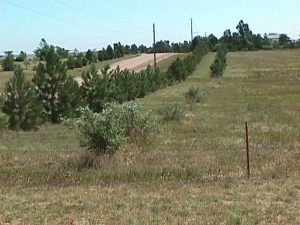Windbreak Planning
 When planning a windbreak it is helpful to determine its purpose. Windbreaks are natural barriers that help reduce or redirect wind. They usually consist of a combination of trees and shrubs. Windbreaks can be planted to provide protection from the wind for people near a homesite, livestock on rangeland or around a feed lot or protection for crops growing in a field. Windbreaks also provide protection and habitat for wildlife.
When planning a windbreak it is helpful to determine its purpose. Windbreaks are natural barriers that help reduce or redirect wind. They usually consist of a combination of trees and shrubs. Windbreaks can be planted to provide protection from the wind for people near a homesite, livestock on rangeland or around a feed lot or protection for crops growing in a field. Windbreaks also provide protection and habitat for wildlife.
A successful windbreak planting depends on proper establishment and care during the first few years after planting. Time spent in site preparation, weed control, and replanting is repaid many times during the lifetime of the windbreak. Take no shortcuts in the planning establishment of your windbreak.
Some of the factors to consider in planning tree plantings are:
- Location
- Elevation
- Soil type and alkalinity
- Prevailing wind direction(s)
- Weed control methods
- Irrigation needs
- Snow drifting
- Power lines
- Planting size and shape
- Site preparation method
- Underground utilities’ location
Generally, the primary tree-planting objective of rural landowners is protection from the wind. A windbreak planting of trees and shrubs creates a “wind shadow” on its leeward (downwind) side, providing that protection. This protected area extends to a distance of 15 to 20 times the height of the windbreak’s tallest trees; the most effective area extends to about 10 times the height (10H) of the windbreak. For example, if a windbreak is 30 feet tall, wind speed is reduced by 50 percent 300 feet downwind from the windbreak.
Because wind eddies form around the ends of a windbreak, the planting should extend 100 feet beyond the area to be protected. Any gaps or openings in the windbreak funnel and accelerate the wind and reduce windbreak effectiveness; planting different types of trees in the same row can create gaps and reduce windbreak effectiveness. Avoid planting tall growing trees under utility lines.
Windbreak rows do not have to be placed in straight east-west or north-south rows but generally should be perpendicular to prevailing winds. Do not plant trees closer than 100 feet to roads, driveways, buildings, or other areas being protected – snow drifts and blind corners created in these areas can be hazardous. (Note: Snow can drift a distance of approximately three times the height of the windbreak.)
Plant at least three rows to achieve good wind protection – the greater the windbreak’s density, the greater the reduction in wind velocity. Shrubs or shorter trees can comprise outer rows, while evergreens (the foundation of the windbreak) should make up at least one inside row. Do not use the same species of plant in every windbreak row; diversification of planting rows increases insect and disease resistance and enhances wildlife habitat. Different tree types should not be alternated or mixed within a row (to avoid plant overtopping by faster growing species).
Before planting, it is best to layout each row of the windbreak on the site. This will allow the design to be customized for the positions of buildings, roads or driveways, feedlots, field boundaries, utility lines, drainage ditches, and other features at the site. Layout the dimensions of the windbreak, including the spacing within and between the rows. This process will help assure that your design will provide the protection needed and will fit within the desired area.
Between-row spacing varies with tree type and weed control methods. When cultivation equipment is used (e.g. disks, rototillers, etc.), spacing should be at least 4 feet wider than the equipment. A minimum spacing of 14 to 20 feet between rows will prevent stunting or overtopping.
Recommended Spacing:
- Shrubs 4′ – 6′ Juniper
- Cedar 6′ – 8′ Pine
- Spruce 8′ – 14′
- Deciduous Trees 10′ – 16′
Species Selection
There are several different species of trees and shrubs that can be planted in a windbreak. The Trees for Conservation Buyer’s Guide put out by the Colorado State Forest Service Nursery and available at your local resource office is an excellent source of information for determining which species to plant in a windbreak. It lists all the seedlings offered by the state. Also consult with your local resource manager to help determine which species to plant.
Site Preparation
Just as a hobby gardener would never consider planting a garden directly in grass sod, people should never consider planting trees or shrubs with little or no site preparation. Preparation of the planting site is key to tree growth and survival. Site preparation involves loosening soil to allow easier planting and proper root development.
The proper depth of the work site should be 6 to 8 inches. Preparation of 4 to 8 foot wide row strips is sufficient for planting. However, if weed barrier mulch is going to be installed, make each tilled row a minimum of 8 feet wide.
Various implements can be used for site preparation, including plows, rototillers, or disks. Most site prep equipment is available at rental store and landscape companies. The end result of the site preparation should be a well worked site worthy of planting a garden.



